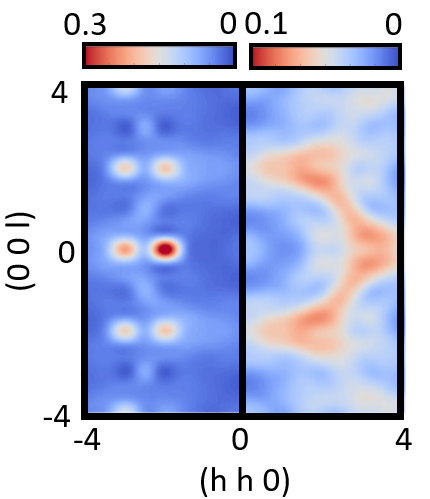
Just as a bar magnet has a magnetic dipole pointing south to north, the motion of electrons around a nucleus gives rise to an atomic-scale magnetic dipole. Inside a material, these atomic magnetic dipoles can arrange in different ways to give rise to magnetic properties.
Many data storage devices use ferromagnetic materials that have separate subregions (domains) within which magnetic dipoles are aligned in the same direction. Depending on whether the domain magnetisation is up or down, a corresponding data bit will have a value of either 1 or 0.

Two ferromagnetic domains with opposing spins.
Logically, the smaller the ferromagnetic domains, the more densely information can be stored. However, very small domains are hard to create and read back, are more susceptible to environmental influences (such as heat) and, when packed closely together, their magnetic fields can interfere. All these factors increase the risk of errors.
With growing demand for smaller and more versatile devices, scientists are looking for new materials in which magnetic dipoles interact to give rise to unusual spin textures, such as knots and vortices. If these smaller spin structures can be reliably stabilised and manipulated, they could be used as information carriers in next-generation devices.
A spiral spin liquid is an enigmatic magnetic state in which spins fluctuate collectively as spirals. Although their existence has been predicted, experimentally, spiral spin liquids are rare because they are very sensitive to structural distortions, which trigger transitions to more conventional magnetic states.
Through a combination of high-resolution and diffuse neutron magnetic scattering studies, researchers from the University of Birmingham and Institut Laue Langevin (ILL) have measured the spiral spin liquid ground state in LiYbO2. This is the first time that this type of spin texture has been observed in an elongated diamond lattice, having only previously been realised in perfect diamond lattices.
Using the WISH diffractometer at the ISIS Neutron and Muon Source, Graham et al. showed experimentally that LiYbO2 fulfils the average theoretical parameters of a spiral spin liquid phase. This was reinforced by complementary diffuse powder scattering studies on the D7 instrument at the ILL, from which it was possible to reconstruct single-crystal diffuse neutron magnetic scattering maps that reveal continuous spiral spin contours—an experimental hallmark of this exotic magnetic phase.
“Neutron scattering is the best tool that we have to be able to measure exotic magnetic phases, such as spiral spin liquids,” says Jennifer Graham, who led this work as part of a PhD research project co-funded by the University of Birmingham and ILL. “What is interesting from an experimental perspective is that spiral spin liquids are partially ordered magnetic ground states - they have contributions arising from average and short-range magnetic exchange interactions - and therefore modelling systems like these are challenging. Our analysis of the D7 data, in which we simultaneously refined the average and short-range features of the data using reverse Monte Carlo analysis, is at the very forefront of the analysis possible on powder samples. This is important, as materials with partial magnetic order
are becoming more prevalent in the field, and so understanding how to model systems like those with spiral spin liquid ground states are essential if quantum magnetic materials are to become functional in the future.”
In proving that the elongated diamond lattice structure of LiYbO2 can host a spiral spin liquid, these findings improve our fundamental understanding of magnetic phenomena and pave the way for the design of new magnetic systems with advanced technological applications.
Read the paper: https://journals.aps.org/prl/abstract/10.1103/PhysRevLett.130.166703
